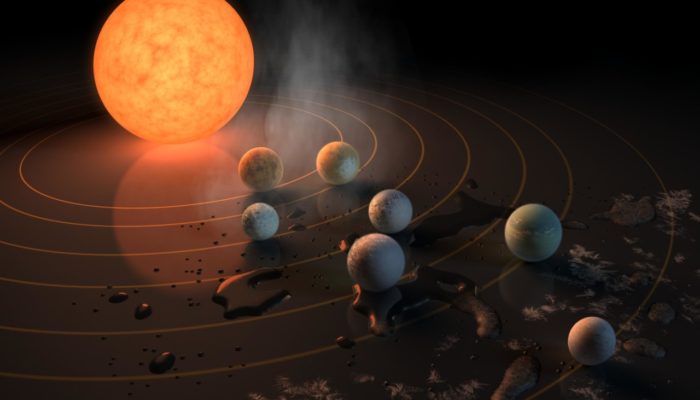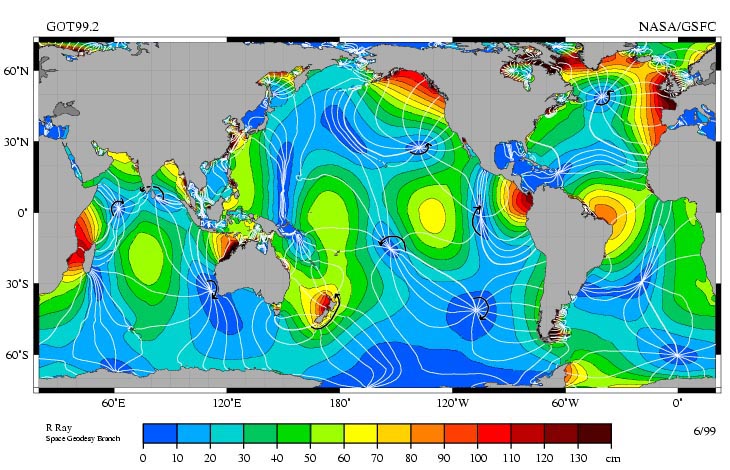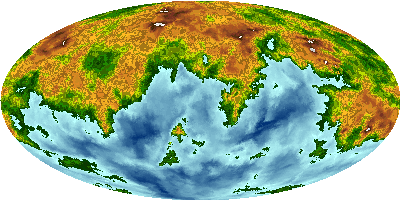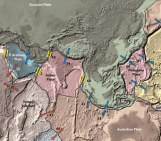
In this edition of “Beyond Tectonics” Ben Blackledge and Hannah Davies talk about worldbuilding and how it can be applied to the discipline of tectonics and tides. Ben Blackledge recently completed his MSc in Bangor and will soon be beginning a PhD in Bristol University.
Let’s begin with a question. Are the tides always the same on every planet? Because of the force of gravity, and interaction between planetary bodies, we know every planet will have tides in some form. However, because every planet is different, the tides cannot be the same everywhere. We know from calculations that they are not; the tide is observably unique on every planet in the solar system. Therefore, by that logic, the tide should be different on every planet in the universe.
Now let’s focus on why the tide is different on every planet, and there are a lot of reasons; the size, chemical composition, proximity to other stellar objects and many other things are in play to affect the tide on a planet, however here, we will focus on the role of planetary topography; or land and ocean distribution on a planet, and the effect that has on the tide.
The next step is to try to quantify this tidal variation for each planet and build a model, build a world. Earth is a good start, but let’s not be too specific. We shall start with Earth size and gravity, and tectonically active too because that is important. Let’s leave out continents for now, and just have an ocean world. Earth’s ocean tide, on a water-world version of Earth, would appear as two bulges in the ocean surface around 40 cm high, the currents of moving water within it simply moving one way then the other.
If we add a continent in the way, this wave will take on a more complex path. If you look at a map of Earth’s M2 tide (the tidal frequency of just the Lunar tide), you’ll see a large amplitude of up to around 1.5m towards the continents, sloping down in to the deep-ocean towards a point of no (tidal) motion, an amphidrome. At the coasts, the range can increase, up to 16m in the Bay of Fundy. Large amplitudes require higher current velocities to maintain them, and these currents lose energy to friction, energy sourced from the angular momentum of the Earth and Moon.

M2 Lunar tide of the Earth illustrated by the colour shade. The white lines are called co-tidal lines, they meet up at points on the Earth where there is “no tide” or no change in the surface of the ocean due to the M2 tide. The arrows around them show the direction the tide moves about the point (Image credit NASA).
Continents are a fundamental part of plate tectonics on Earth so that is why the role of tectonics is key, some of Earth’s basins, such as the North Atlantic, are in a near resonant state the M2 tide, so it is just about the right size for one tidal wavelength, making a more efficient wave, generating large amplitudes. The outer boundaries of continents are often shallow shelf seas which accelerate tidal currents, removing a substantial amount of energy from the system. Islands and Archipelagos, such as the Hawaiian Islands and the Indo-Pacific islands, can remove energy from the tidal wave by generating large submarine waves, called internal tides. All mechanisms tied to the tectonic and volcanic evolution of the Earth’s surface. An ocean floor that is smoother, or continents which are smaller, or positioned differently, will alter the tide quite dramatically.
So, with all that in mind, how could we test these processes on other planets? We employed worldbuilding in two methods to help understand the role of topography (tectonics) in affecting the tidal state of a planet.
Randomised map makers
Topography and continents are not considered in models of exoplanet oceanic and atmospheric tides, because you would clearly be making large assumptions about the surface history of these planets if you did. But we can test the effect of altering Earth’s topography. The planet’s surface is not really the result of random processes, but continents are approximately fractal-like (although, not true fractals). Using techniques originally intended for computer game map design we can produce large ensembles of randomised, but realistic, continental configurations. Islands, supercontinents, polar continents and what are essentially water worlds are all easily produced and can be run as bathymetry within tidal models. Run enough of them, and we can begin to test the influence of specific features statistically.

Five representative maps made with the map generator discussed above. Credit Torben Mogensen
Planetary maps made from hypotheses of future supercontinents
In recent years much advancement has been made in the areas of digital map creation for the purpose of deep time studies, and alongside this, reconstructions of the past Earth have also increased in detail far back into Earth’s history. However, forays into the future remained rare, often just a thought experiment by a geologist or two. Davies et al., (2018) aimed to change that. Davies et al., (2018) is a review of four of the most popular ideas of what the Earth will look like in 200 to 250 Million years. The maps presented within would not be out of place on a worldbuilding forum. The maps are based on established theories of how plate tectonics will shape the Earth as it moves the continents around over the next few hundred million years.
Much like fantasy maps, these maps can be used as a foundation for other things. These maps have since been used to test the state of the tide into the future to understand if the present day does have abnormally strong tides.
Can worldbuilding be applied to your work too?
The sections above were just two examples of how worldbuilding can contribute to science, however there are other examples too such as when making Interstellar (James et al., 2015), or on World of Warcraft. An important ability for any scientist is to be able to think outside the box, and to use tools others may have dismissed. I encourage all of you to let out your inner nerd, because building a model of the real world is not much different to building a fantasy world when you think about the methods employed to make each.
Written by Ben Blackledge and Hannah Davies
References
James, O. et al., 2015: Gravitational lensing by spinning black holes in astrophysics, and in the movie Interstellar. Classic and Quantum Gravity, 32 065001. https://doi.org/10.1088/0264-9381/32/6/065001
Davies, H.S., Green, J.A.M., & Duarte, J.D. 2018: Back to the future: Testing different scenarios fo the next supercontinent gathering. Global and planetary change, 169, 133 – 144. https://doi.org/10.1016/j.gloplacha.2018.07.015


